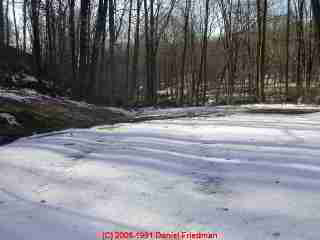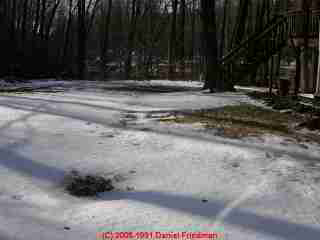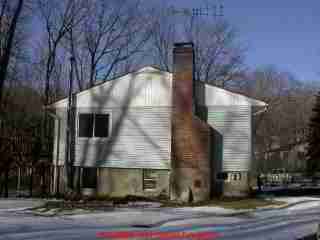 Green Grass, Brown Grass, Melting Snow Over the Septic Tank or Drainfield
Green Grass, Brown Grass, Melting Snow Over the Septic Tank or Drainfield
- POST a QUESTION or COMMENT about finding septic tank or soak beds by noting melting snow or quality of grass cover
Septic tank and drainfield condition & location indicators by grass colour or snow melt:
Greener grass, browner grass, melting snow are clues to the condition of the septic system, septic tank, piping, and drainfield.
This article explains what these mean, and provides suggestions and procedures for further investigation to diagnose these conditions. These clues also help locate the septic tank.
InspectAPedia tolerates no conflicts of interest. We have no relationship with advertisers, products, or services discussed at this website.
- Daniel Friedman, Publisher/Editor/Author - See WHO ARE WE?
Snowmelt over the Septic Tank or Drainfield - what do they mean?
Question: what is the meaning of greener grass over our septic tank? Why are we now seeing melted snow in the same area of the septic tank? Is this a problem?
We just moved into a house first time with septic. We had the septic tank inspected and drained. [Unless it has already been done, when buying a home that's new to you, it's a good idea to have the septic tank pumped and cleaned out and inspected. - Ed.].
We noticed that directly above the septic tank there is bright green grass - different in color from any other in the yard. Now after the snow has fallen it has melted away over the same septic tank spot. It looks as if the ground under the tank is hot and it is defrosting the ground. It does not appear to be mushy and there is no odor. Is this normal? - Rookie with the septic system. - Thanks for your help. (Anon).
Reply: your septic system clues sound normal but here is how we can check for developing septic system trouble:
Meaning of Melted Snow Over a Septic Tank
 Snow melt and even greener grass over the septic tank might be normal, or it could mean trouble. The absence of odors
Snow melt and even greener grass over the septic tank might be normal, or it could mean trouble. The absence of odors
or wet or soggy areas
(SEPTIC DRAINFIELD FAILURE DIAGNOSIS) is good news, as would be the
absence of any sewage backup into the home
Similarly, snow melt over the drainfield trenches (our page top photo) is not necessarily an indication of a failing system.
If in addition, your septic pumper didn't see any signs of trouble when the septic tank was pumped, then the "normal" conditions we describe below for septic tanks may be just what you are seeing.
It would be helpful to see some photos of the area over the tank with snow melt (and later with greener grass), and while you're at it, take some photos of where you think the drainfield is located so that together we can see if there are depressions, snowmelt, soggy areas, etc.
Snowmelt over the septic tank may be normal: often the bacterial action in the tank is enough to generate some heat, as is the incoming warm water from the house, so if the top of tank is not far below ground surface, snow may melt there first, especially if the snowfall thickness is not great. This is common and not a problem.
More photos of snow melt over the septic tank are
at VISUAL CLUES LOCATE the SEPTIC TANK
Guide to Diagnosing Snowmelt or Green Grass Over the Septic Tank
You can easily diagnose this condition by opening the inspection cover over the septic tank outlet end. If the sewage level is just up to the bottom of the tank outlet pipe where it passes through the tank wall, that's normal.
If sewage is above the bottom edge of the horizontal portion of the outlet pipe then the outlet pipe or drainfield are backing up. Details about this procedure including photos are found
Explanation of Greener Grass over the Septic Tank
Greener grass over the septic tank
may be the result of someone seeding that area if the tank cover was excavated for service. But greener grass over the septic tank may also be a sign that the tank is leaking around its cover - which would be an abnormal condition and a sign of trouble.
A backing up pipe to leachfield (or worse, a failing leachfield) could cause effluent to drain too slowly out of the septic tank or back up even into the building.
Explanation of Brown Dead Grass over the Septic Tank
Browner grass may also be present over a septic tank if the tank top is not very deep below ground. A shallow septic tank top means that there will be less soil thickness, leading to soil dryout during dry weather, leading to dead grass in that area.
See SEPTIC TANK DEPTH for a discussion of how deep the septic tank might be.
 Visual clues often help find the location of a septic tank, starting outside the area where the main waste line leaves the house.
In this winter example, the depression near the house marks the septic tank cleanout which in this case was close to the
surface.
Visual clues often help find the location of a septic tank, starting outside the area where the main waste line leaves the house.
In this winter example, the depression near the house marks the septic tank cleanout which in this case was close to the
surface.
As we discuss in more detail
at VISUAL CLUES LOCATE the SEPTIC TANK, summarized below are some clues that help locate the septic system.
- Stones, slates, stakes, or other markers
may have been left by a previous building owner to show the location of a septic tank pumpout access cover. - Pipes sticking up out of the ground,
perhaps between 10' and 20' from the home, especially if they are 4" to 6" diameter cast iron or white or black plastic, may mark vents or cleanouts on the waste line between the building and the septic tank, or they may mark the location of the tank itself. Some septic pumping companies install a 6" top 8" "riser" pipe with a cap close to ground level (maybe painted green by the homeowner) which they use as a quick access port to pump the septic tank.
It's easy to see if one of these ports is right over the tank, if one removes the pipe cap and peers inside, perhaps with a flashlight. (SAFETY WARNING: do not walk over or near septic tanks where there are signs of impending collapse, such as soil subsidence). - Electrical boxes sticking up out of the ground
might mark the location of electrical connections feeding electrical components used in some septic systems. Examples include septic tanks using effluent pumps to move effluent to an uphill location, pumping chambers using sewage grinder pumps to force sewage to an uphill septic tank and drainfield. A video showing a septic tank with a pumping station and its electrical connections is
at Septic 101 part 1: Video on How to find the septic system - Rectangular depressions of perhaps 4 ft. x 8 ft.
On the other hand, on rare occasions there may be a raised rectangular area if soils settled away from the septic tank. This happened at one of our properties because the bottom of the septic tank was sitting on bedrock and after backfill some soils around the tank settled and compacted but the tank didn't move a bit. - Rectangular areas of less grass growth -
if the tank is not buried very deep there is less soil over it - Areas of more lush grass growth -
if the tank is leaking or backing up and spilling effluent around itself, the grass will be greener around the septic tank. - Depressions in the soil
of perhaps 2 sq.ft. that may mark a previous excavation for tank pumping - Snow melt: in climates where snow falls, areas of melted snow may mark the top of the septic tank (or areas of a failing leach field). A photo of this clue showing drainfield trenches as depressions in the snow can be seen
at VisualClues to Location - Drawings or sketches of septic tank location
are sometimes found in a building's basement or crawl space, sketched on a surface near the point where the main waste pipe exits the building. And of course a thoughtful owner may have left a drawing on paper somewhere for the new owners. An example of a sketch locating septic system components is
at RECORDS to LOCATE the DRAINFIELD. - Wet areas or smelly areas
which may indicate a failing drainfield. Also septic odors. - Pipes ending in streams, lakes, or swamps,
or at the edge of a property sometimes mark an overflow drain that was added to cope with a failing septic system. A photo of one of these is
at UNLIKELY DRAINFIELD LOCATIONS - Thanks to reader (anonymous) for discussing the meaning of snowmelt or greener grass over the septic tank (12/2010);
- Thanks to Donica Ben
who points out the danger of digging into buried electrical wires (11/11/07) as we discuss further
at Septic & Cesspool Safety Procedures - Clogged Drain Diagnosis - is the problem the septic system or the Building drain system?
Septic Tank Safety: Septic System, Septic Tank, & Cesspool Safety Warnings for Septic Inspectors, Septic Pumpers, and Homeowners - Septic Tank Condition - How to Inspect Septic Tanks and evaluate the septic tank condition, baffles, sludge levels, damage, evidence of septic failure
- SEPTIC DRAINFIELD SHAPE: septic drainfield or leaching bed shape and placement considerations
- SEPTIC DRAINFIELD LOCATION: how to find the septic drain field or leaching bed
- Drainfield Inspection Procedure Septic Leach Fields - how to inspect and diagnose septic drainfield failures
...
Continue reading at VISUAL CLUES LOCATE the SEPTIC TANK or select a topic from the closely-related articles below, or see the complete ARTICLE INDEX.
Or see these
Recommended Articles
Suggested citation for this web page
SEPTIC TANK GRASS or SNOWMELT at InspectApedia.com - online encyclopedia of building & environmental inspection, testing, diagnosis, repair, & problem prevention advice.
Or see this
INDEX to RELATED ARTICLES: ARTICLE INDEX to SEPTIC SYSTEMS
Or use the SEARCH BOX found below to Ask a Question or Search InspectApedia
Ask a Question or Search InspectApedia
Try the search box just below, or if you prefer, post a question or comment in the Comments box below and we will respond promptly.
Search the InspectApedia website
Note: appearance of your Comment below may be delayed: if your comment contains an image, photograph, web link, or text that looks to the software as if it might be a web link, your posting will appear after it has been approved by a moderator. Apologies for the delay.
Only one image can be added per comment but you can post as many comments, and therefore images, as you like.
You will not receive a notification when a response to your question has been posted.
Please bookmark this page to make it easy for you to check back for our response.
IF above you see "Comment Form is loading comments..." then COMMENT BOX - countable.ca / bawkbox.com IS NOT WORKING.
In any case you are welcome to send an email directly to us at InspectApedia.com at editor@inspectApedia.com
We'll reply to you directly. Please help us help you by noting, in your email, the URL of the InspectApedia page where you wanted to comment.
Citations & References
In addition to any citations in the article above, a full list is available on request.
- New York State Department of Health, APPENDIX 75-A WASTEWATER TREATMENT STANDARDS - INDIVIDUAL HOUSEHOLD SYSTEMS , [PDF] New York State Department of Health, 3 February 2010, retrieved 3/1/2010, original source: https://www.health.ny.gov/regulations/nycrr/title_10/part_75/appendix_75-a.htm
- Our recommended books about building & mechanical systems design, inspection, problem diagnosis, and repair, and about indoor environment and IAQ testing, diagnosis, and cleanup are at the InspectAPedia Bookstore. Also see our Book Reviews - InspectAPedia.
- In addition to citations & references found in this article, see the research citations given at the end of the related articles found at our suggested
CONTINUE READING or RECOMMENDED ARTICLES.
- Carson, Dunlop & Associates Ltd., 120 Carlton Street Suite 407, Toronto ON M5A 4K2. Tel: (416) 964-9415 1-800-268-7070 Email: info@carsondunlop.com. Alan Carson is a past president of ASHI, the American Society of Home Inspectors.
Thanks to Alan Carson and Bob Dunlop, for permission for InspectAPedia to use text excerpts from The HOME REFERENCE BOOK - the Encyclopedia of Homes and to use illustrations from The ILLUSTRATED HOME .
Carson Dunlop Associates provides extensive home inspection education and report writing material. In gratitude we provide links to tsome Carson Dunlop Associates products and services.

